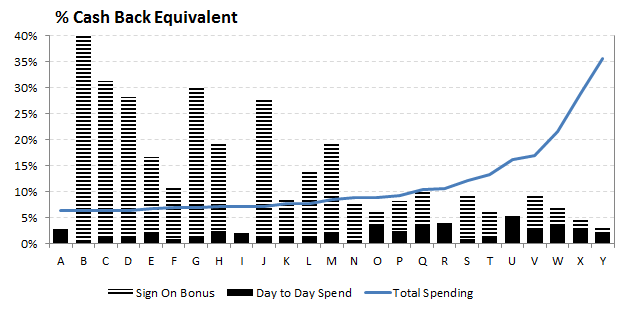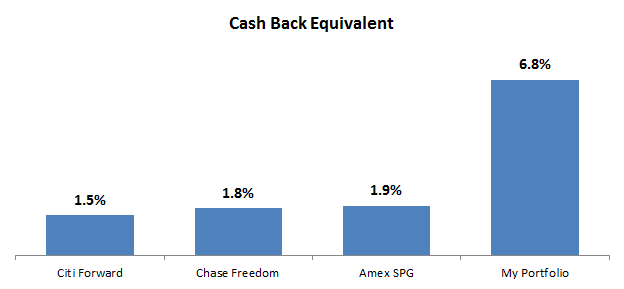A Math Nerd’s Quest to Become A Points & Miles Millionaire – An Accounting Exercise

This is part two of A Math Nerd’s Quest to Become A Points & Miles Millionaire.
- Introduction
- An Accounting Exercise
- Manufactured Spending
- Status & Perks
- Why Stop at Miles and Points?
Now that I am a points & miles millionaire, I wish I were a real millionaire. The truth is, there’s a pretty big difference between the two.
How, then, do I quantify my treasure chest of travel currencies? In this article, I will share how my thought process evolved.
THE TYPICAL APPROACH
Unless this is the first time you stumbled upon a travel blog, chances are you have seen statements like “I value abc points at x cents each”. The idea is that you can exchange each point for x cents worth of travel, after factoring in opportunity costs such as how award flights don’t earn you miles back. Exactly how the valuation works varies from person to person, and depends on an individual’s travel preferences. It’s not uncommon to see entire posts dedicated to challenging other bloggers’ methodologies, but most people seem to agree within a reasonable range.
These valuations are good reference points in evaluating relative value of travel currencies. For example, people generally rate United MileagePlus miles at 1.5 cents each, so when I’m presented with an opportunity to redeem 25,000 miles for a $200 flight, I should probably pass and wait for something better. Also, because SPG points are valued at >= 2.0 cents and Hilton points are valued at <= 0.5 cents, I’d have a rough idea whether I prefer one of the former or three of the latter.
For such valuations to be meaningful, though, they must represent the average of many redemption options. Just because somebody happens to book a last-minute award flight during the holiday season, when ticket prices are through the roof, doesn’t make the miles worth 10 cents apiece. Some bloggers appear to spend more time in the air than on the ground, so I trust their numbers as representative of a large number of data points. However, I’m not a frequent traveler and my experiences may not align with the “average”. To account for my points & miles net worth, I’ve got different ideas.

Park Hyatt Abu Dhabi – where we have a reward stay next week
CASH BACK EQUIVALENT
It hasn’t been long since I thought credit cards were all about cash gift-card backs. So, at the onset of my journey, I was planning to account for each of my credit card earnings as a cash back equivalent. Moreover, I knew that if I only spend the minimum required for the sign-on bonus, the resulting value would be incredibly high. For example, the Chase Hyatt card gives you two free night certificates after spending $1,000 within three months. If I used those at Park Hyatt New York, which frequently retails for $1,000 per night, wouldn’t I get a 200% cash back equivalent? WHO WOULDN’T WANT 200% CASH BACK ON THEIR PURCHASES??
Turned out it wasn’t quite possible to charge every dime of my purchases toward a new credit card’s sign-on bonus, because the number of credit card products on the market is, surprisingly, finite. As fun as it has been to apply for 10 new cards per year, I can’t imagine anyone getting away with triple that amount.
What gets messier is that points and miles are harder to spend down than cash. I’ve kept many such currencies long after closing the credit card accounts, so I do need a proxy to help me estimate the eventual cash value. In addition, some trips require more points than I could accrue on a single credit card, so I’d have to pool points from several sources to book an award trip. When that happens, I will have to pro-rate the value of the trip across the cards. A per-point value becomes a useful proxy again. Apparently it’s not possible to maximize a complex system while keeping everything simple. Guess I can’t have the cake and eat it too.
MODIFIED METHODOLOGY
After some thought, I decided to go with a hybrid approach:
First is the already redeemed rewards. A bird in the hand is worth two in the bush, and the redeemed points are the only points guaranteed to have value. Our three-night stay at Hyatt Regency TST in Hong Kong, for example, had a price tag of $814. My Barclay Arrival Plus rewards, on the other hand, offset $450 of our stay at Carlton Hotel Singapore. I’d take these price tags on my redemption, and multiply the total by a factor of 0.9. The 10% reduction reflects a combination of the direct opportunity costs, and a recognition that more cost-effective options may exist outside the points system.
Second is the outstanding points and miles balance that I’m not sure when I will use. I start with TPG’s valuation. I choose this benchmark because it is the most comprehensive and frequently updated list, despite it seemingly a bit generous. Before applying it to my balance, I multiply these point values by a factor of 0.8. This reduction reflects the uncertainty in how much I will agree with this blogger about the points’ value, and what percentage of these points I will ultimately be able to use.
Now that I arrive at a fairly conservative valuation of my points (redeemed + outstanding), I divide that amount by the total spending over the same time period. For cards on which I paid an annual fee, I deduct the fee from the points value first. The result is an impressive 6.8% cash back equivalent!
Okay, honestly, 6.8% is more modest than what I had assumed in my head (like, 20%). The chart below will explain why my perception is skewed:

Twenty-five of my credit cards are sorted by total spend on this chart, and their cash back equivalent (CBE) percentages are expressed as both including and excluding the sign-on bonus. A few of these cards did not have the sign-on bonus component, because they were opened before this 30-month experimental period. A few observations:
- There is an inverse relationship between the CBE and the total spend on the card. This makes sense – the more money you charge to a card, the less significant the sign-on bonus appears to be. In my case, it also means more dollars in a non-bonus spending category and therefore a lower points earning ratio
- Chase IHG (B) has a whopping 40% CBE! But that’s because I only recently got the card and haven’t put much spend on it
- Citi Forward (R) at 4.0% and Chase Freedom (U) at 5.4% are my highest return cards when excluding sign-on bonus. This is because they both have 5% categories, and I rarely put non-bonus spend on them. Chase Freedom also benefits from TPG’s generous valuation of Ultimate Rewards points
- Amex SPG (Y) has been my favorite card where non-bonus spend goes by default. It returns a solid 2.0% on the day-to-day purchases, which few other cards can come close
OTHER CONSIDERATIONS
While not incorporated into the analysis, I’ve got some additional thoughts related to the value of points and miles:
- The best part about points and miles is not that they will offset your cash cost, but that they may offset your cash cost. Sort of like having a call option in a highly volatile stock market, there is tremendous value in being able to pay with an alternative currency, while the cash price jumps up and down sporadically. For those craving a technical example, see Terence’s recent post
- Having more points in a program makes each point more valuable: 8,000 miles get you no award flight; 80,000 get you an international round trip, which is a lot more valuable than 10x of nothing
- Hotel points are generally more flexible and easier to redeem, than airline miles. The majority of points I’ve used so far went toward hotel stays. It’s hard to quantify, but the ease of use has gotta count for something

Taj Deccan Hyderabad – where we have a paid stay next week
FINAL TALLY
While 6.8% does not seem jaw-dropping, it is substantially better than my original (lack of) strategy. Let’s take a look at what % CBE I could have earned, if I had charged all my expenses on a single card:

Do you have an actively managed portfolio of credit cards? What is your cash back equivalent?
Cool post! Love looking at points and miles in an analytical way, and this is definitely one of the more interesting views I’ve seen lately!